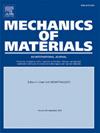Modeling the large deformation and fracture of polymer-metal-polymer film composites – Part Ι: Constitutive behavior
IF 3.4
3区 材料科学
Q2 MATERIALS SCIENCE, MULTIDISCIPLINARY
引用次数: 0
Abstract
The utilization of polymer-metal-polymer film (PMPF) is widespread due to its exceptional mechanical ductility, chemical stability, and impermeability to air. Nevertheless, the intricate manufacturing process and the multi-layered metal-polymer composition of this composite film contribute to its anisotropic mechanical attributes, posing challenges in modeling large deformations and fractures. In part I of this study, we mainly focus on modeling the constitutive behavior of PMPF.
PMPF's stress-strain response displays a distinct crossover characteristic not found in any isolated constitutive models. This study proposes a layered model that amalgamates Hill 48 elastoplastic and orthotropic Fung hyperelastic behaviors to account for the internal structure of the composite film. To expedite model calibration, we establish an optimization-based method, integrating an analytical solution for the layered model's uniaxial behavior in diverse orientations. Moreover, a parametric study into the layered structure subjected to punch loading furnishes insights for parameter identification, mitigating potential solution multiplicity. Calibration involves uniaxial tensile tests at distinct material orientations and punch tests. Through comparison of experimental and finite element outcomes spanning multiple loading conditions for two commercial PMPFs, the validity of the approach is demonstrated. This endeavor lays the foundation for more profound exploration into the fracture behavior of this composite material.
求助全文
约1分钟内获得全文
求助全文
来源期刊

Mechanics of Materials
工程技术-材料科学:综合
CiteScore
7.60
自引率
5.10%
发文量
243
审稿时长
46 days
期刊介绍:
Mechanics of Materials is a forum for original scientific research on the flow, fracture, and general constitutive behavior of geophysical, geotechnical and technological materials, with balanced coverage of advanced technological and natural materials, with balanced coverage of theoretical, experimental, and field investigations. Of special concern are macroscopic predictions based on microscopic models, identification of microscopic structures from limited overall macroscopic data, experimental and field results that lead to fundamental understanding of the behavior of materials, and coordinated experimental and analytical investigations that culminate in theories with predictive quality.
 求助内容:
求助内容: 应助结果提醒方式:
应助结果提醒方式:


